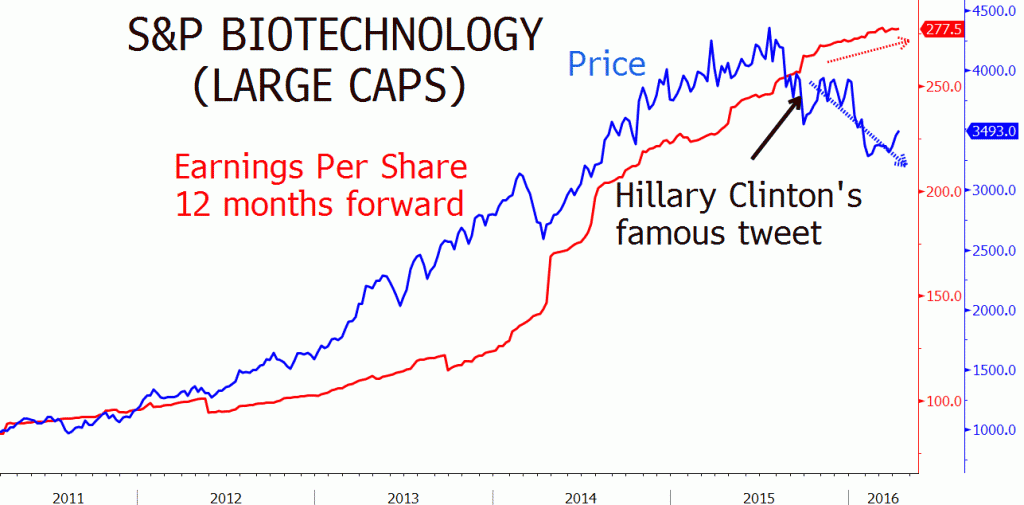Biotechnology: a fallen angel or a buying opportunity?
The recent performance of the biotech sector has been truly dismal since Hillary Clinton sent her famous tweet on 21st Sept 2015: “Price gouging like this in the specialty drug market is outrageous. Tomorrow I’ll lay out a plan to take it on.”

During the last 3 quarters, profits in the biotech sector have continued to increase (red line in the chart) whereas stock prices have been falling (blue line in the chart). By June 30th, 2015, the sector traded at PE multiples in line with the S&P500 and today it trades at 25% discount!
The index shown is the S&P 500 Biotechnology Industry Index GICS Level 3 (S5BIOTX), whose components are the large caps: Alexion, Amgen, AbbVie, Regeneron, Celgene, Baxalta, Gilead, Biogen and Vertex. These companies are profitable, whereas the most widely known Nasdaq Biotechnology Index is broader and contains also the mid and small caps Biotech companies that in many cases are not profitable yet.
What has been the driver for such bad performance? Hillary Clinton is making aggressive proposals that might damage the pharmaceutical and biotechnology sectors. The most damaging ones for the biotechnology sector would be:
- Enable US government to directly negotiate drug prices and so pressing for an overall decrease in prices.
- Limit exclusivity for biotech drugs from 12 to 7 years.
Will these reforms be approved? Current polls shows that Hillary might be the Democrat candidate and will likely beat Trump, the presumable candidate from the Republican Party. On the other hand, some of these proposals might be stalled under a Republican-led Congress. The Senate is more difficult to predict, but it seems that it will be also controlled by the Republican Party, who is friendlier with the pharma companies.
In case the reforms are approved, what will be the impact on profits? Difficult to estimate, and that is one of the main reasons why the sector has underperformed.
Any other reason for the underperformance? Sarepta and PTC Therapeutics (Duchenne muscular dystrophy) suffered regulatory setbacks and had dramatic falls in prices, although both of them had about $3 bn. market cap only.
Why would the sector recover the historical upward trend?
- The growth story has not changed: “Innovation is still firmly entrenched as the main tailwind and should be for some time to come. Advances in potentially first-in-class and/or disruptive therapies are increasingly frequent (immune-oncology, gene editing, etc.) with plenty of activity on the horizon over the next 12-24 months; biotech companies across the cap spectrum are involved” (JPMorgan).
- FDA productivity remains high. In general the FDA is committed to accelerated development where appropriate (orphan drugs for instance)
- Valuation: the S&P Biotech index is currently trading at 12.3x 12moth forward, 25% discount to the SP500.
- Merger & Acquisitions: Companies in the sector have cash and might be taken over by large pharma companies. Bloomberg Intelligence estimates that US pharma companies have about $200 bn. in combined debt capacity to make acquisitions. Also the largest Biotech funds may have more than $125 billion in debt capacity to fund M&A or licensing deals.
Difficult to call a bottom in such a complex sector which is exposed to political risk, but there are some reasons to believe that there is an attractive asymmetrical risk profile for buyers in the biotech sector, one of the few growth sectors in the current macroeconomic environment.